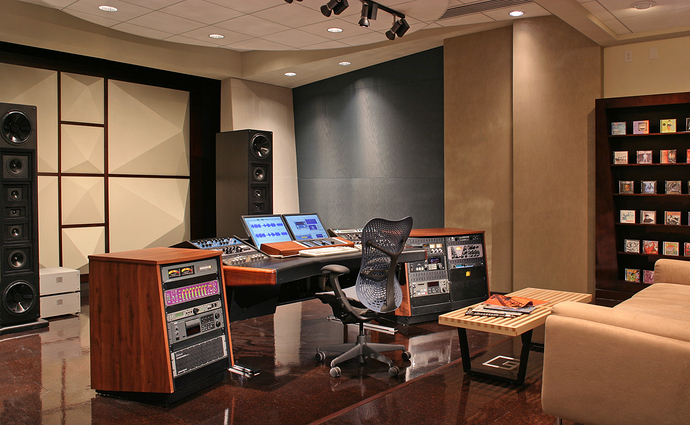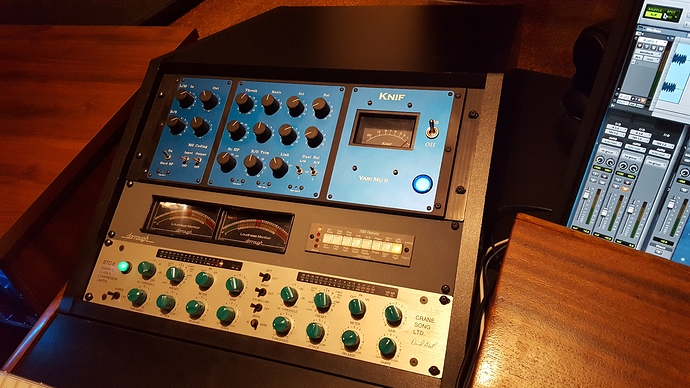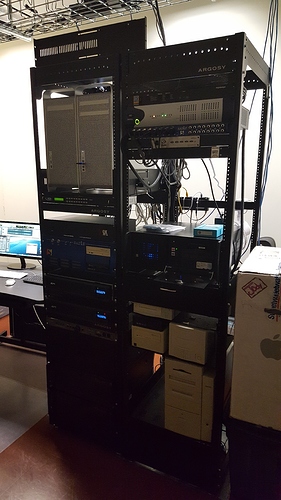Just got back from Charlotte NC, after a visit to Dave Harris of Studio B mastering. My phone had 2% battery by the time I realized you guys would get a kick out of seeing this, so I was fumbling through questions as fast as I could before the battery died lol. This room is a no-compromises build by one of the leading acoustic experts in the world. The clarity from the room and those monitors was absolutely breathtaking.
I cannot believe you called them “speakers”.
Gosh, I almost called them ‘high-tech’, which would have sounded really awful, but I was trying to think faster than my phone was trying to die on me. lol. …and I think when he said anything under “$3000 is total shit”, he meant “I’ve never heard of or know about a speaker in that price range that is capable of producing a compression free wave form, sufficient for mastering work in my opinion”.
Haha…what I thought was funny was
"Do you use the tape machine much".
“Yes.”
(Next question please) lol.
I always find it interesting seeing these rooms like this an then seeing the monitors being blocked by the desk like that. I guess I don’t get it. How do you have an accurate monitoring setup if some of the drivers on that tower are being hidden by the desk?
If only low frequency drivers were being blocked by the desk, I could understand, but it looks like midrange and high frequency drivers are being impacted.
Very cool Jonathan, thanks for thinking of us and sharing!
In regard to that he remarked “The transient response can’t keep up with the actual waveform.”
I remember AJ talking about the NS-10’s and saying he liked them because they do a better job of managing the “time domain” or something like that. I’d have to find one of the old threads to remember exactly what it is or what it’s called, but your conversation with the ME reminded me of that. Based on what the ME said, the amplifier is the key, and quality (i.e. “expensive”) is what makes the difference. Not the monitor design. I’d be interested to know exactly why that happens and what the (expensive) amplifier does differently, just for curiosities’ sake.
This may seem nitpicking, but when he says “the actual waveform”, I would disagree and say there IS no actual waveform! What we call a waveform is just a term that refers to the artificially created visual representation of a segment of audio signal over time. It’s a convenient “representation” (created for the DAW experience), not a real thing. Perhaps you could call it a ‘facsimile’, but if he’s going to that level of technicality and finesse to explain these things to us and then tosses out a dumbed-down technical term (IMO) I was scratching my head. I guess I was expecting more of an explanation of “time domain” (or whatever it actually is).
I was wondering aboot this too. Fire them right into the front of the desk, maybe the desk creates the “live” sound dispersion?
He’s a mastering engineer not a acoustic or electrical engineer and what I can find from an on-line bio is that he was previously a musician and probably has little knowledge about the inner workings of his equipment as it is not necessary for his job.
Beautiful room and very nice rack(s) of outboard hardware.
But according to OP
I would guess that if the room was designed by someone who knew what he was doing, this effect was taken into account. I’ve seen many images of mastering studios with a similar setup, so I have a hard time believing it’s as damaging as it looks.
Yes, I agree and I’m guessing that the effect of the desk placement has little or no impact on the sound.
Link to review of his monitors: Dunlavy SC V monitors
Link to his power amps: Cello Performance II
Okay, a little history. He mentions Cello amplifiers. Cello was the company Mark Levinson created after he was bought out of his original company, which was called “Mark Levinson”. I had the pleasure of going to a training at his loft in Manhattan, and was completely blown away by the quality and precision of the products he made. To properly answer your question, a very good amplifier has a control and quickness of a good speaker that a mediocre amplifier can never have. First, you’ll notice four boxes on the floor, 2 power supplies and two amps. This allows each amplifier to draw current from its’ own very large transformer, so it never lacks for power. By providing sufficient clean power to the amplifier, it is easy for the amp to push sufficient current to the drivers to accurately control their motion, which can eliminate a lot of blurring that can be caused by an amp that doesn’t have the strength and stability to accurately move the driver in and out with no wasted motion. Compare this to a home receiver, whose single transformer needs to power 7 speakers, and weighs about 8 pounds vs. the 50 pound beast in the Cello amps, and there are two of them. Then of course, no expense is spared on the parts used in the amp itself, so there is a ton of headroom available. At that point, the dynamic range in the recording is reproduced accurately with no distortion. The slew rate of those amps, and the current they provide are incredible, so they can pull power, deliver it and reload many times faster than standard stuff.
As to the speaker position, I think the photo is misleading, they are probably farther away than they look, and it is a point source design, so the image is being projected from the middle of the speaker, which would be tall enough to where the desk was not a problem. If you are ever fortunate enough to hear a Levinson, or Cello, or Krell system with speakers like the Duntechs, you will be truly shocked with the immediacy and snap that can be produced. I don’t remember what the Cello amps sold for, but it would be like buying a house to have that setup.
I have no idea. I can’t even begin to hypothesize how its even possible for a room to sound that crazy clear.
I have no idea how much AJ does or doesn’t know about stuff like that. I really sort of suspend judgement on it, because I’m in no position to call it either way. I simply not knowledgeable enough about this stuff to where I could tell if he knew what he was talking about or not.
Same here. I understand the general concept. That sub $3k monitors make compromises in the amplifier section, and the amplifier (I think its called the damping factor or slew rate) is responsible for the handling of fast transients. It did surprise me (as you can see from the video) that he said that…it was the first time I’ve even heard someone talk about it.
I know he said ‘actual waveform’ but, I think the referring to what the transient time. Transients are a real thing…right? If the attack time of the amp is slower than the attack of the transient, the amp compromises the transient in the same way the attack time of a compressor compromises the transient. I don’t think he was suggesting that you can compresses a transient as if it was a physical loaf of bread lol.
One thing I’ve noticed about these half million dollar small rooms (which I think is a decent dollar amount to build a 600sq ft space, though its rice and beans if you’re trying to build a mix room). They are remarkably consistent as you move around. I had a tremendously experienced mix engineer in a room with me last week. I was sitting behind an SSL 9J. He was calling out suggestions from the back corner only 2 feet away from the wall. I stopped for a second and asked how on earth he could even hear back there. As the track was playing, I walked back there myself, and was absolutely dumbfounded as to how the image didn’t change or distort the slightest bit as you moved back. You still could hear fader moves that were only 1db. You could hear changes from 2:1 to 4:1 on the 2 bus compressor, you could CLEARLY hear the differences between the SSL comp and the Fairchild on the 2 bus, even listening from the worst possible place in that entire room.
That’s exactly what I understood from the conversation.
Cool…Yes - Slew rate…I thought that’s what it was called. Couldn’t remember the name.
You get what you pay for.
I would say ‘yes’. Though that begs the question: “If a tree falls in a forest, and nobody is there to hear it, does it cause a transient?” 
I wouldn’t characterize the attack time of a compressor “compromising” a signal, because it’s something you’re doing (hopefully) intentionally. More like ‘impacting’ or attenuating. But I agree that analogy works with the amp in question as you might fooled into believing it is ‘flat’ and ‘accurate’, and you might be obliviously deluded or mistaken. Or accepting less than you’d like in terms of quality but telling yourself it’s “really great”.
If it’s a time domain thing, I might choose the word ‘blurring’ rather than compressing. Then again, I could be mistaken. 
The other cool system I was fortunate enough to hear was at Dan D’Agostino’s house in CT. He was the founder of Krell amps. This was back when Laser Discs were the ultimate in video reproduction. He had 3 Krell Mono Blocks per side, with separate power supplies. Each stack was about six feet tall. The main speakers were Wilson Grand Slams, which were somewhat like a very refined array system. He explained to us that to truly represent the transient of scissors cutting paper would require about 10,000 watts of power.
He then put on Terminator 2, which starts out with a robot stepping on skulls. When you heard the bones snap through that system it was an absolutely visceral experience. Yeah, it was about $350,000 for the package, but it’s only money if you own the company.
A lot to be said for the differences! Cool stuff.
Was anyone denying this? I mean, I never denied it. I said you could make a sexy ass mix without a good studio. That doesn’t mean you can’t make an even sexier mix on a super expensive system in a magical room. I know I’ll never put out anything that sounds like it was recorded at Sound City and mastered and Masterdisk, but I can make something that’s at least listenable.
Now I want my fucking golden ears too. Interesting, gold is more valuable than platinum right now.
This has been a great, fun, and interesting discussion … but right about now I feel like that dog that pooped in the wrong place and got his nose shoved in his own sh*t. 
 I know it’s been frustrating for you Jonathan, harping on all this for such a long time, and we haven’t fully appreciated it, but today it started to finally part the clouds and reveal a ray of sunshine that felt quite refreshing. No need to rub it in.
I know it’s been frustrating for you Jonathan, harping on all this for such a long time, and we haven’t fully appreciated it, but today it started to finally part the clouds and reveal a ray of sunshine that felt quite refreshing. No need to rub it in. 
I sold high end audio gear for 25 years, and took pride in the fact that if you explained what to listen for, it is very apparent to anyone how big the differences are in better systems. That’s not to say that everyone is going to be able to own some of the best gear, but it helps them to identify the gear that sounds the best for what they can afford, and what to strive for.
It’s sad that for a variety of reasons many younger people have no frame of reference for this. There is a very low priority for most people when it comes to listening to what has become a commodity that you shouldn’t even pay for anymore.
I don’t own much in the way of a home studio, but I have two levels of appreciation: one for the home studio person who gets very good results with minimal gear, and a second level for a fully equipped professional studio that takes full advantage of a great room and knows what to do with it to ring the last drop of emotion out of an artist who is worthy to be there,.
In my mind, those are two separate worlds, but if you’ve never heard the difference, your frame of reference shouldn’t allow you to disqualify how different those worlds are.
Crap i didn’t know that all i had to do was tell you you were right and i would have golden ears. Dude of course if i had access to a great room and good hardware i would give it a go and i know that i would really appreciate many aspects of it a lot. I didn’t know that was what you wanted. It is just about as close to an impossibility for me as having a platinum record. (or own much platinum for that matter). I am hoping to have a dedicated recording and mixing space some time in the next 10 years. That is a realistic goal so I am going to spend my time trying to make the best music i can with in those limitations. i don’t have time to dream about or talk about the difference a million bucks would make to my recordings. That is why i have never engaged with you regarding this subject and will not again after this post.
i just found the way that you phrased your comment make me feel like we are a bunch of idiots who can’t see the light to making good music. Well i think that despite the limitations many of us face in this area we are going to hear good music being made and i want to be a part of that.


